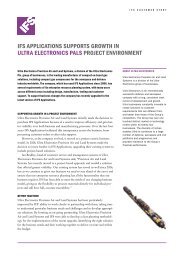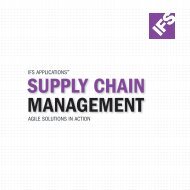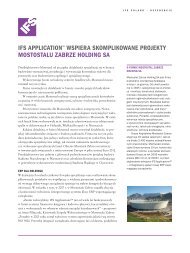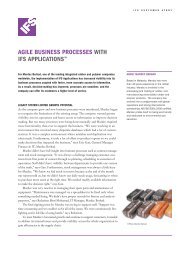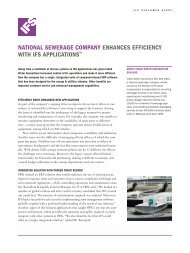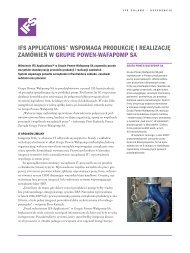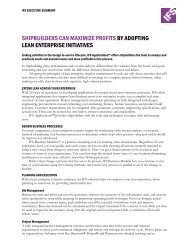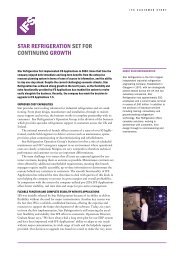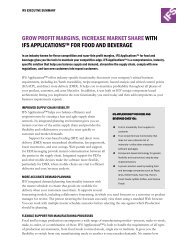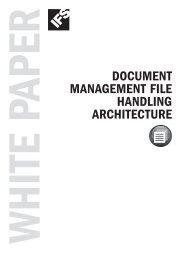Project Enterprise - IFS
Project Enterprise - IFS
Project Enterprise - IFS
You also want an ePaper? Increase the reach of your titles
YUMPU automatically turns print PDFs into web optimized ePapers that Google loves.
<strong>IFS</strong> EXECUTIVE SUMMARY<br />
<strong>IFS</strong> APPLICATIONS OFFERS THE COMPLETE SOLUTION FOR<br />
TODAY’S PROJECT ENTERPRISE<br />
The <strong>Project</strong> <strong>Enterprise</strong>—which manages services, or builds products or facilities using project management<br />
techniques—has a unique set of business requirements. But traditional ERP systems lack the functionality and<br />
flexibility to meet the needs of today’s project-centric organization.<br />
<strong>IFS</strong> Applications is the solution. With its open, component-based architecture and rich project management<br />
functionality, <strong>IFS</strong> delivers an integrated business solution that helps the <strong>Project</strong> <strong>Enterprise</strong> to improve project<br />
management, boost profits, and take advantage of new business opportunities.<br />
WHAT IS THE PROJECT ENTERPRISE?<br />
Design &<br />
The <strong>Project</strong> <strong>Enterprise</strong> is an organization that<br />
Estimating<br />
Cost<br />
Re-use<br />
uses a project management system to control<br />
Management<br />
and manage the complete lifecycle, from<br />
Commissioning<br />
Finance<br />
quotation, design, procurement, construction,<br />
<strong>Project</strong><br />
and commission—and often the service<br />
The<br />
maintenance of the end product. The<br />
Build /<br />
Document<br />
Bid<br />
Manufacture<br />
Management<br />
organization strives to reuse as much<br />
Contract<br />
knowledge as possible from one contract to<br />
Change<br />
Management<br />
Collaboration<br />
the next, enhancing the bid management<br />
Management<br />
process, improving customer service, and<br />
Resource<br />
delivering repeatable operational profitably.<br />
Procurement<br />
Management<br />
Sub-contract<br />
The <strong>Project</strong> <strong>Enterprise</strong> needs visibility to<br />
ensure that it designs and produces products<br />
that meet contractual obligations. So when there are changes in the complex interrelationships between<br />
activity dates and resource constraints, the project manager must reassess supply and demand needs, and then<br />
adjust the balance to optimize delivery capability and minimize costs.<br />
In complex projects, the <strong>Project</strong> <strong>Enterprise</strong> must constantly balance the demand for resources, facilities,<br />
cash, and skills. Too much or too little of any resource affects the bottom line. Financial reporting must be<br />
interactive. Although period-end routines are adequate for regulatory compliance, they mean little to the<br />
project manager, who needs real-time data.<br />
Timely, accessible information is the key to a project’s success. Therefore, it is critical that project<br />
management drive all activities.<br />
WHAT DOES <strong>IFS</strong> OFFER THE PROJECT ENTERPRISE?<br />
By integrating enterprise resources planning (ERP) with project management capabilities, <strong>IFS</strong> Applications<br />
gives the <strong>Project</strong> <strong>Enterprise</strong> visibility and control at both the local and global levels. The <strong>IFS</strong> solution is<br />
appropriate for companies that control and manage their brand and design portfolio while outsourcing<br />
production. Such companies are found in a variety of industries, including shipbuilding, complex<br />
manufacturing, construction, and aerospace and defense. In the future, more organizations will be touched by<br />
the project-driven economy, including make-to-stock businesses, which must identify project-specific<br />
manufacturing and inventory during product development.<br />
The <strong>IFS</strong> solution is built on open standards, with a set of components that provides a complete projectcentric<br />
business solution. It offers both internal and external users centralized, real-time visibility of all project
<strong>IFS</strong> EXECUTIVE SUMMARY<br />
information. This information ranges from project-related key performance indicators (KPIs) to detailed work<br />
assignments and tasks for individual team members, embracing design, manufacturing, build, installation, and<br />
supplier and subcontractor deliverables.<br />
The work breakdown structure (WBS) acts as an umbrella connecting all business activities and<br />
deliverables. It integrates production, people, materials, procurement, physical deliverables, expenses, time,<br />
electronic documents, and specifications within the project. The WBS drives and controls the project’s time<br />
line, providing the framework needed to ensure that all accountable project members have access to their own<br />
responsibilities and deliverables.<br />
ACCESSING PROJECT DATA<br />
The project or program manager can review progress by clicking any connected project activity, including<br />
designs, specifications, change requests, resource time bookings, expense charges, supply requisitions,<br />
purchase orders, build orders, service or installation orders, documents, drawings, health and safety profiles,<br />
invoices, and credit notes. By having access to the current status of every task, the manager can focus time and<br />
effort only on activities falling outside predetermined parameters. This allows for timely corrective action and<br />
risk mitigation.<br />
OPTIMIZING PROJECT MANAGEMENT RESOURCES<br />
By focusing on key issues, project managers can spend quality time reviewing and ensuring adherence to<br />
contractual obligations, avoiding costly penalties. They can analyze areas of underperformance and initiate<br />
timely, effective cost containment actions.<br />
Because a project may contain hundreds of parallel activities, the project manager must be able to view<br />
the project at both macro and micro levels. By analyzing the status of subprojects, the manager can pinpoint<br />
tasks that threaten timely completion.<br />
REPLANNING PROJECT DATES<br />
In the perfect world, the completion date of a project would never change once released. But all too often a<br />
project requires rescheduling, and the project manager must adjust all tasks and deliverables accordingly. In<br />
many project organizations, the design is far from complete when it is time to place orders for items with long<br />
lead times and to reserve key resources or capacity. Therefore, a best guess is often made early in the project<br />
lifecycle.<br />
To ensure that demand and supply are synchronized, the project manager must be able to make changes<br />
that cascade down to all levels of the project plan. In the <strong>Project</strong> <strong>Enterprise</strong>, the project manager can test the<br />
impact of rescheduling a complete project or a subproject. Once a decision has been made regarding the<br />
change of dates, physical design attributes, or any other contract details, the impact is automatically calculated<br />
and cascaded down the plan with immediate visibility.<br />
INTEGRATING ENGINEERING<br />
Taking information directly from the CAD system to create the engineering specifications for procurement,<br />
subcontracting, and build activities reduces effort and removes any risk of error. It becomes easy to track<br />
changes, and the differences between as-ordered, as-designed, as-built, and as-commissioned are managed in<br />
the same system.
<strong>IFS</strong> EXECUTIVE SUMMARY<br />
REUSING PROJECT DATA<br />
The ability to copy information from previous projects or use predefined project templates improves bid<br />
quality. Reuse reduces effort in the resource-consuming bid process as well as in the planning and budgeting<br />
phases. Web portal technology enables collaboration so that designs, engineering data, specifications, and<br />
drawings can be exchanged and approved directly, speeding up the process and eliminating transcription<br />
errors.<br />
<strong>IFS</strong> Applications allows the transfer of as-commissioned design specifications into the software<br />
components that manage the in-service lifecycle of the asset, minimizing effort and risk by eliminating the<br />
need to re-create the data. In maintenance, repair, and overhaul (MRO) organizations, the as-commissioned<br />
and as-serviced technical specifications and appropriate drawings can be made available to the overhaul<br />
process automatically, increasing quotation reliability, improving quality, and minimizing risk.<br />
LEARN MORE<br />
For more information on how <strong>IFS</strong> Applications helps the <strong>Project</strong> <strong>Enterprise</strong> increase efficiency and<br />
profitability, enhance customer loyalty, and take advantage of new business opportunities, call (888) 437-4968,<br />
or visit www.ifsworld.com.



